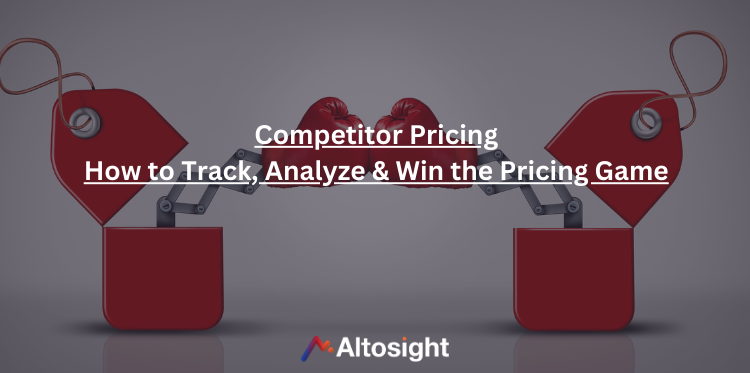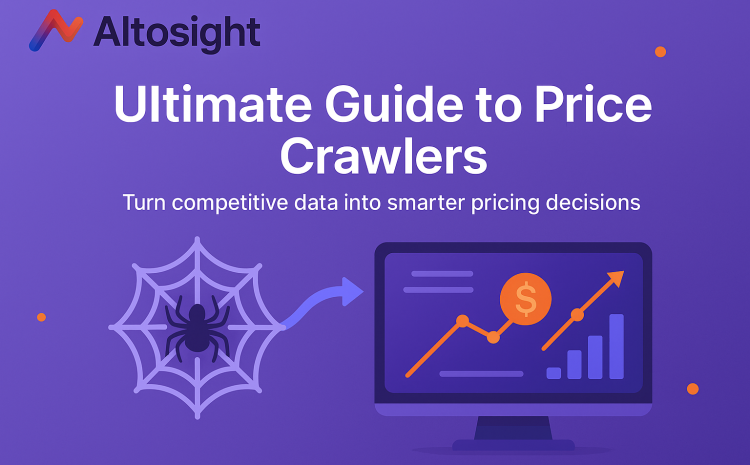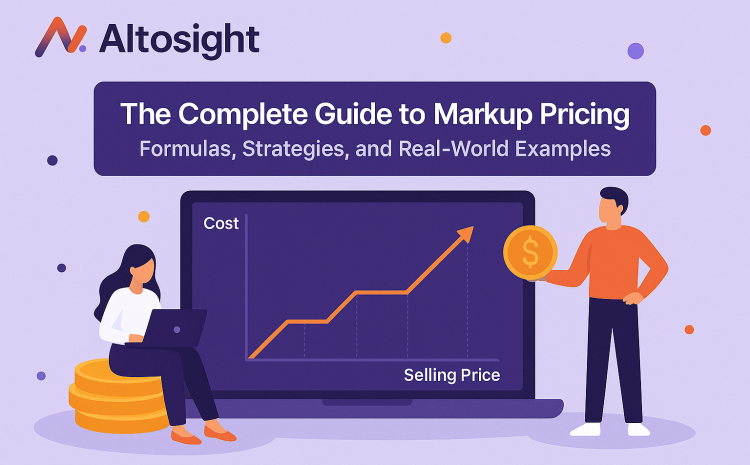
83% of online shoppers compare prices before making a purchase. In one simple click, they can leave your listing and land on your competitors. Any way you slice it, price comparison has become second nature for the modern consumer.
How do you make your offer good enough to guarantee the sale while protecting your profits?
Running an online store puts you in a transparent marketplace. Every price change, every promotion, every move you make lives in full view of both customers and competitors. Smart pricing strategies make this transparency work for you instead of against you.
Losing sales hurts — especially when you can’t pinpoint why. Often, the answer lies in pricing, but racing to become the cheapest option generally leads nowhere good.
The real win comes from finding that perfect balance where prices attract customers while protecting your profits.
Modern eCommerce thrives on data-driven pricing. When you track and analyze competitor pricing data systematically, patterns surface.
You’ll see which price points drive conversions, when to adjust for market changes, and how to maintain margins even as competition intensifies. Higher conversion rates, increased order value, and stronger market share follow naturally.
Powerful analysis tools eliminate pricing guesswork. Instead of relying on gut feelings or outdated assumptions, your pricing decisions flow from real-time competitive pricing data. Market intelligence guides every move, turning price optimization from art to science.
What is Competitor Pricing?
Competitor pricing builds your pricing strategy around market dynamics rather than relying solely on production costs or dreamy margins. Your pricing decisions factor in competitor behaviors, market positioning, and customer perception to maximize both sales and profitability.
Core Pricing Approaches
Your eCommerce pricing strategy typically falls into one of these proven approaches:
- Price Matching: Match your competitors’ prices precisely to neutralize price as a deciding factor. This strategy is perfect for established brands with strong customer loyalty who want to maintain market share without triggering price wars. Many electronics retailers use this strategy during peak shopping seasons.
- Price Undercutting: Set prices slightly below market rates to attract price-conscious shoppers. This strategy works effectively when you have optimized operations and can maintain profitability at lower prices. New market entrants often employ this strategy to build their initial customer base and market share.
- Premium Pricing: Position your products at higher price points than competitors, emphasizing superior quality, unique features, or brand prestige. This strategy is successful when backed by a strong brand identity and clear value differentiators. Apple consistently uses this strategy across its product lines.
Amazon’s Competitor Pricing Mastery
Amazon exemplifies sophisticated competitor pricing in action. Their marketplace success stems from a comprehensive pricing system that monitors competitor price movements across millions of products.
Advanced algorithms analyze competitive pricing data continuously to enable automated price adjustments that maintain optimal market positioning.
Amazon’s Competitive Price Threshold (CPT) is a good system for starters that empowers marketplace sellers with competitor pricing data, helping them start competitive while preserving profitability.
Important note: The CPT system—short for Competitive Price Threshold—is designed to analyze real-time market data and automatically adjust your product pricing. This ensures that your prices remain competitive while protecting profit margins by responding quickly to market shifts. However, it’s worth noting that while CPT is highly effective within the Amazon ecosystem, it may not be as robust as dedicated 3rd party dynamic repricers. These specialized solutions often offer more granular pricing adjustments, multi-channel integration and advanced algorithms that account for additional factors such as inventory levels, shipping costs and broader market trends. As a result, 3rd party dynamic repricers can provide a more comprehensive pricing strategy for sellers operating across multiple platforms or facing diverse market conditions.
Direct-to-consumer brands are increasingly adopting similar data-driven approaches, using competitive pricing analysis to defend market share against established retailers and emerging competitors.
Competitive Pricing Strategies & How They Work
Successful eCommerce pricing requires a sophisticated blend of market awareness, customer psychology, and competitive pricing data analysis. Modern pricing strategies extend beyond simple cost-plus calculations or competitor matching by adapting to market conditions, customer segments, and perceived value propositions.
The right pricing strategy is a powerful growth driver when backed by accurate competitor pricing data and market intelligence. Each approach serves specific business objectives, from rapid market penetration to premium brand positioning.
Dynamic Pricing in Action
Dynamic pricing adjusts your product prices in real-time based on market conditions, competitor movements, and demand patterns.
Leading airlines exemplify this approach, modifying ticket prices hundreds of times each day based on seat availability, competitor rates, and booking patterns.
For eCommerce stores, dynamic pricing helps maintain optimal market position while preserving margins during peak demand periods.
Strategic Market Penetration
Penetration pricing temporarily positions your products below market rates to capture market share and establish a brand presence.
This strategy proves particularly effective when launching new product lines or entering established markets. Once you’ve built a solid customer base, prices gradually increase to standard market levels while maintaining customer loyalty through demonstrated value.
Value-Based Positioning
Value-based pricing aligns your prices with customer perception of your product’s worth rather than focusing solely on competitive price analysis.
Premium brands like Apple successfully implement this strategy by emphasizing unique features, superior quality, and brand prestige. Your pricing reflects the additional value customers receive from choosing your products over competitors.
Customer Segmentation Strategies
Price discrimination recognizes that different customer segments have varying price sensitivities and value perceptions.
You might offer premium pricing for enterprise customers while maintaining competitive pricing for individual consumers. Using this approach maximizes revenue across all customer segments.
The Airbnb Pricing Revolution
Let’s look at how Airbnb mastered competitive pricing data to change the rental market forever. Their strategy works so well that many eCommerce brands across every industry mimic it.
Core Dynamic Pricing Components
| Component | What It Does | Why It Matters |
| Market Analysis | Gathers competitor pricing data from hotels and rentals. | Helps hosts price competitively in their local market. |
| Demand Forecasting | Predicts busy periods and quiet times. | Allows hosts to raise or lower prices at the right moment. |
| Location Impact | Evaluates how nearby attractions affect pricing. | Ensures prices match what guests will pay for the area. |
| Real-time Updates | Changes prices automatically as the market shifts. | Keeps listings competitive without constant manual work. |
Strategic Price Optimization
Think of pricing like a dimmer switch instead of an on/off button. You need to adjust gradually based on what’s happening around you. Airbnb’s system helps hosts find the perfect brightness—or, in this case, the perfect price—for every situation.
Competitive Pricing Analysis: How to Gather & Use Data
Staying competitive in eCommerce means keeping a constant pulse on market prices. But manually tracking competitor prices across multiple platforms quickly becomes overwhelming. Let’s explore how successful online retailers gather and use competitive pricing data effectively.
Automated Price Monitoring Solutions
AI-powered tools like Altosight eliminate the manual work of competitor price tracking. These platforms continuously monitor your competitors’ pricing moves and automatically suggest adjustments that keep you competitive while protecting your margins. You can spot opportunities instantly without spending hours scanning competitor websites.
Key Features of Modern Price Monitoring
- Real-Time Price Tracking: Get instant alerts when competitors change their prices.
- Multi-Platform Monitoring: Track prices across Amazon, direct-to-consumer sites, and other marketplaces.
- Profit Protection: Set minimum margins to ensure price adjustments stay profitable.
- Customer Pricing Rules: Create specific strategies for different product categories or competitors.
Making Sense of Market Data
Smart price tracking reveals patterns you can use to get ahead. For example, an electronics retailer noticed their competitor’s gaming accessory prices always jumped during new game releases.
Using this insight, they timed their own price adjustments perfectly to capture more sales during peak periods while keeping strong margins the rest of the time.
Essential Market Indicators
- Seasonal Changes: Spot natural price shifts throughout the year.
- Sale Patterns: Know when competitors typically run promotions.
- Price Ranges: Find the sweet spot for your products in the market.
- Stock Levels: See how product availability affects market prices.
Beyond Price Monitoring
Price tracking tools now deliver much more than basic competitor data. You’ll see entire product lines, new launches, and stock level changes across your market.
This complete view helps you make better decisions about both pricing and inventory—keeping you one step ahead of market shifts.
Why AI & Automation Are Key in Competitor Pricing
Market intelligence transforms your pricing from reactive guesswork into a powerful sales driver. Automated pricing tools give you complete market visibility—when competitors change prices, when stock runs low, and when new opportunities present themselves.
Your store moves from playing catch-up to leading the market through data-driven decisions.
The Power of AI-Driven Price Intelligence
Modern pricing platforms like Altosight use artificial intelligence to monitor competitor pricing data across the entire market. It’s akin to having a dedicated team of pricing experts working for you around the clock.
While other sellers struggle with manual price checking, your store responds automatically to market shifts. Smart price adjustments happen at precisely the right moment to capture sales opportunities that others miss—all while protecting your margins.
Winning With Automated Intelligence
- Seize Market Gaps: Profitable opportunities appear when competitors make pricing errors or run low on inventory.
- Guard Brand Value: MAP violations stop before unauthorized sellers can damage your brand position.
- Predict Competitor Moves: Historical pricing patterns reveal likely competitor strategies before they execute.
- Scale Strategically: Real data supports testing new price points and market segments.
The Real-Time Advantage
A leading sports equipment brand was losing $50,000 monthly to MAP violations and price erosion from delayed responses to market changes. Their team spent 30 hours every week checking prices manually across 200+ resellers.
After implementing automated competitive pricing data tracking, they caught violations within minutes instead of days. Their team redirected those 30 hours to strategic work while improving profit margins by 15% through better price positioning.
The point is that competitive pricing data only matters when you can act on it quickly.
Price wars start without warning. New sellers enter overnight. Stock levels shift constantly. AI-powered pricing tools turn market volatility into opportunity.
Modern eCommerce is a whole new ballgame when real-time competitive price analysis drives profitable decisions—not because it’s a new technology, but because it delivers proven results for your bottom line.
Competitive Pricing in Action: Real-World Examples
Major retailers demonstrate just how powerful automated competitive pricing data becomes at scale.
A study revealed Amazon and Walmart matched prices 70% of the time across identical products, while Target only aligned with Amazon prices 26% of the time.
Such precise price matching across vast product catalogs requires sophisticated automation.
Inside the Amazon-Walmart Price Battle
Each retail giant constantly monitors competitor pricing data, making hundreds of price adjustments daily. When Walmart drops a price, Amazon’s system detects the change within minutes.
Algorithms analyze the price difference, check profit margins, and adjust Amazon’s price automatically – creating a continuous cycle of price optimization that sometimes leads to multiple changes per hour.
Fashion retailers learned valuable lessons from this approach, adapting it to their unique seasonal challenges.
Smart Seasonal Pricing in Fashion
Fashion retailers face complex pricing decisions with seasonal inventory. Leading brands like Zara use competitive price analysis to perfect their markdown timing.
Rather than merely matching competitor discounts, they analyze historical pricing patterns alongside current market data. Smart algorithms determine the ideal moment for price adjustments – moving inventory efficiently while maintaining brand value and profitability.
Direct-to-consumer brands took this sophisticated approach even further, proving that strategic pricing beats price wars every time.
How DTC Brands Win Without Price Wars
Direct-to-consumer brands demonstrate that the lowest prices don’t always win. One premium cookware brand watched competitors repeatedly slash prices in a race to the bottom.
Instead of joining them, they used market pricing analysis to identify sweet spots where quality perception and profit margins intersect. Their automated system maintained these strategic price positions while competitors struggled with vanishing profits.
The lesson? Automated price monitoring provides the intelligence to compete strategically rather than reactively.
Smart brands use competitive pricing analytics to find profitable opportunities without sacrificing margins to unnecessary discounting – just as Amazon and Walmart demonstrated in their sophisticated price matching dance.
Mistakes to Avoid in Competitor Pricing
Competitive pricing data loses value when used incorrectly. Many retailers make costly mistakes trying to match or beat competitor prices without considering the bigger market picture.
Moving Beyond Price Wars
Slashing prices might win a few quick sales but often starts a downward spiral. After matching every competitor’s price drop for three months, one electronics retailer learned this lesson.
Their sales volume increased by 30%, but profit margins fell so low that higher sales actually meant less profit. Smart pricing strategies focus on finding optimal price points that drive sales while protecting margins.
Protecting Brand Value
Premium brands face unique pricing challenges. A luxury skincare company maintained high prices while competitors ran deep discounts.
Using market pricing analysis, they discovered their core customers valued consistency and quality over discounts. Their automated pricing system kept prices stable during competitor sales, adjusting only when competitive pricing data showed sustainable market shifts.
The Cost of Bad Data
Outdated or inaccurate competitor pricing data leads to poor decisions. Manual price checking often misses important details like shipping costs, bundle deals, or regional variations. Modern pricing tools track these variables automatically, ensuring your pricing decisions reflect true market conditions.
Reading Market Signals
Sales volume tells only part of the story. One furniture retailer maintained steady prices despite falling competitor rates, noticing their competitive price analysis showed strong demand in their target market segment.
Instead of dropping prices, they focused marketing on quality-conscious customers, maintaining profits while competitors struggled with thin margins.
The key? Strategic pricing requires both accurate data and intelligent analysis. Price matching alone rarely wins long-term success. The most successful brands use comprehensive competitive pricing analytics to find profitable opportunities other retailers miss.
How to Implement a Competitive Pricing Strategy for Your Business
Creating an effective pricing strategy requires a systematic approach backed by reliable, competitive pricing data. Let’s break down each essential step.
Step 1: Identify Your Key Competitors
Direct competitors sell identical products to your same target market. A running shoe retailer competes directly with other athletic footwear stores targeting runners and athletes. Understanding these core competitors provides your baseline for price positioning.
Indirect competitors satisfy similar customer needs differently. For running shoes, high-end fashion retailers and general sporting goods stores create pricing pressure even though they’re not direct competitors. Tracking both competitor types gives you complete market visibility.
Step 2: Automate Your Price Tracking
Manual competitor price checking fails in modern ecommerce. Even with a dedicated team, you’ll miss crucial price changes and market movements that affect your sales. Automated tools deliver accurate, real-time competitive pricing data across all relevant marketplaces.
Price monitoring platforms like Altosight scan thousands of competitor prices hourly, spotting patterns human researchers would miss. Market pricing analysis happens automatically, showing you exactly where your prices stand compared to competitors.
Step 3: Build Smart Pricing Rules
Dynamic pricing rules protect your margins while keeping prices competitive. Set minimum profit thresholds for each product category, then create rules for automatic adjustments when competitor prices change. Your prices stay optimized even during demand surges or competitive pressure.
Sophisticated rule sets account for shipping costs, bundle deals, and seasonal factors. One electronics retailer increased profits 12% by adjusting prices automatically based on competitor stock levels and historical demand patterns.
Step 4: Test and Refine
Price testing reveals what really drives sales in your market. Start with small adjustments across different product categories, measuring the impact on both sales volume and profit margins. Use competitor pricing analysis to identify optimal testing windows.
Regular A/B testing of pricing strategies shows which approaches work best for different products and seasons. Track key metrics like conversion rates and average order value to measure success.
Step 5: Align With Brand Position
Premium brands need pricing strategies that reinforce their market position. A luxury watch retailer maintains prices 15% above market average, using competitive price analysis to ensure they never drift too far from the premium segment sweet spot.
Strong brands balance competitiveness with value perception. Monitor how price changes affect brand sentiment and customer lifetime value, not just immediate sales numbers.
Quick Implementation Checklist
- Identify Key Competitors: List both direct and indirect competitors.
- Automate Price Tracking: Use tools like Altosight for real-time monitoring.
- Set Smart Pricing Rules: Define profit thresholds and dynamic adjustment rules.
- Test and Optimize: Run A/B tests to determine the most effective pricing strategies.
- Monitor Market Trends: Regularly review competitor data and adjust accordingly.
Key Takeaways & Actionable Steps
Modern ecommerce demands sophisticated pricing strategies backed by accurate competitive pricing data. Manual price checking and reactive adjustments no longer work in a market where prices change by the minute and competitors watch your every move.
Your Path to Pricing Success
Smart pricing strategies start with reliable data. Platforms like Altosight monitor your market around the clock, delivering competitor pricing data that drives profitable decisions.
Clear insights show when to adjust prices, which products have room for higher margins, and where opportunities exist to capture more market share.
But strategic pricing means more than matching competitor moves. Sophisticated rules consider your brand position, profit requirements, and market dynamics. When competitors start price wars, intelligent positioning maintains profitability without resorting to desperate discounting.
Get Your Pricing Right With Altosight
Stores running automated pricing systems see immediate improvements. Teams redirect energy from manual price checking to growth strategies. Sales increase as prices stay perfectly aligned with market conditions. Margins grow through smart rules that prevent unnecessary discounts.
Every pricing decision stems from real market intelligence rather than guesswork.
The market rewards businesses that price strategically. Automated competitive price analysis transforms pricing from a constant challenge into a sustainable competitive advantage. Your success starts with the right tools and the right data.
Join the growing community of successful online retailers who turned pricing into their competitive advantage with Altosight. Experience the power of automated competitive price analysis in your store. Schedule Your Demo today and learn more about how we can help your business drive results.





